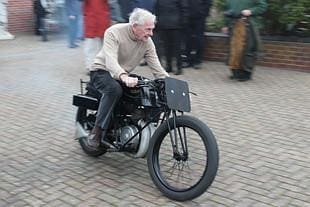
Often overshadowed by the museum’s bigger, faster machines, the Villiers-engined two-stroke is still a significant motorcycle in the history of the circuit. Arguably a man ahead of his time, Tommy Meeten nurtured the two-stroke faith. He rode small capacity Francis-Barnetts at Brooklands in both as solo and sidecar classes.
Small and light, the Meeten bike was easily transported in one of the volunteer’s vehicles. The day was a chance for museum volunteers (a first time for most) to view the Sammy Miller collection and see another approach, like Brooklands, to preserve the best of powered two- (and occasionally three-) wheeler history.
As well as the opportunity to look around the museum, Sam invited groups into his spacious workshop where a busy schedule tackles restorations for customers, or prepares more bikes for the already well-filled museum. Road-race bikes included a rare Harley-Davidson and an equally uncommon three-cylinder Crescent. They shared workshop space with a V-twin James among several works in progress.
 Later, it was time to fire up the bikes. Tommy Meeten’s special expansion exhausts on the Francis-Barnett crackled as it was warmed briefly, before handing it over to Sammy, who took it for a few laps around the generous courtyard contained by the museum buildings. Then he and Bob Stanley started the supercharged V-4 AJS, the bike on which Walter Rusk became the first person to post a 100mph lap at a British circuit. Also warmed -up briefly, Sam needed space to take the AJS for further laps, with a high first gear and the engine at far from optimum revolutions the harsh exhaust note bounced off the surrounding buildings. It was left to the imagination as to how the bike must have sounded flat out on the high-speed Clady circuit, the home of the Ulster GP at that time.
Later, it was time to fire up the bikes. Tommy Meeten’s special expansion exhausts on the Francis-Barnett crackled as it was warmed briefly, before handing it over to Sammy, who took it for a few laps around the generous courtyard contained by the museum buildings. Then he and Bob Stanley started the supercharged V-4 AJS, the bike on which Walter Rusk became the first person to post a 100mph lap at a British circuit. Also warmed -up briefly, Sam needed space to take the AJS for further laps, with a high first gear and the engine at far from optimum revolutions the harsh exhaust note bounced off the surrounding buildings. It was left to the imagination as to how the bike must have sounded flat out on the high-speed Clady circuit, the home of the Ulster GP at that time.
It was another memorable outing for all those who attended. Like Brooklands, there was far too much to see in one day, so it looks as if a further visit is on the cards.


